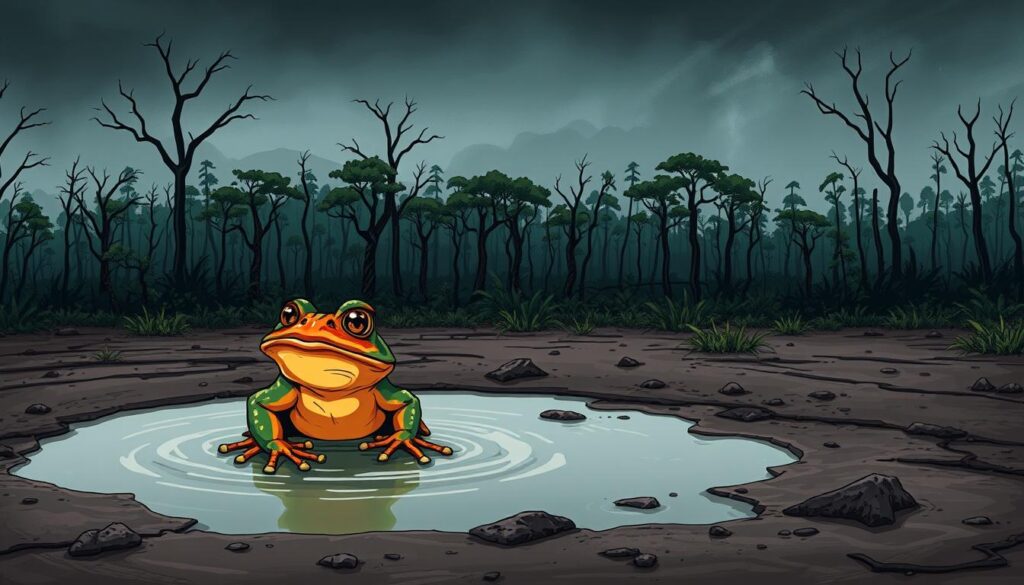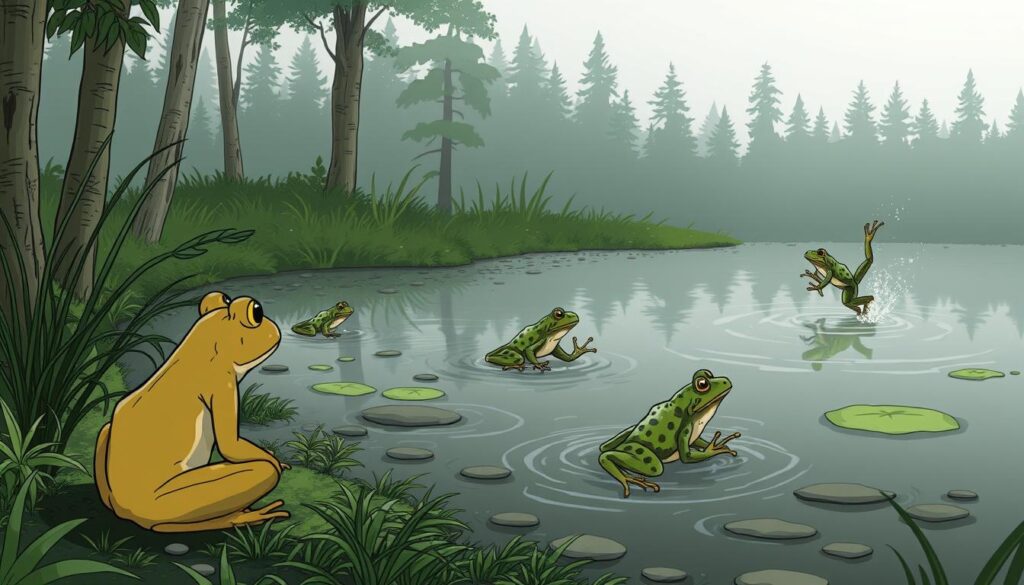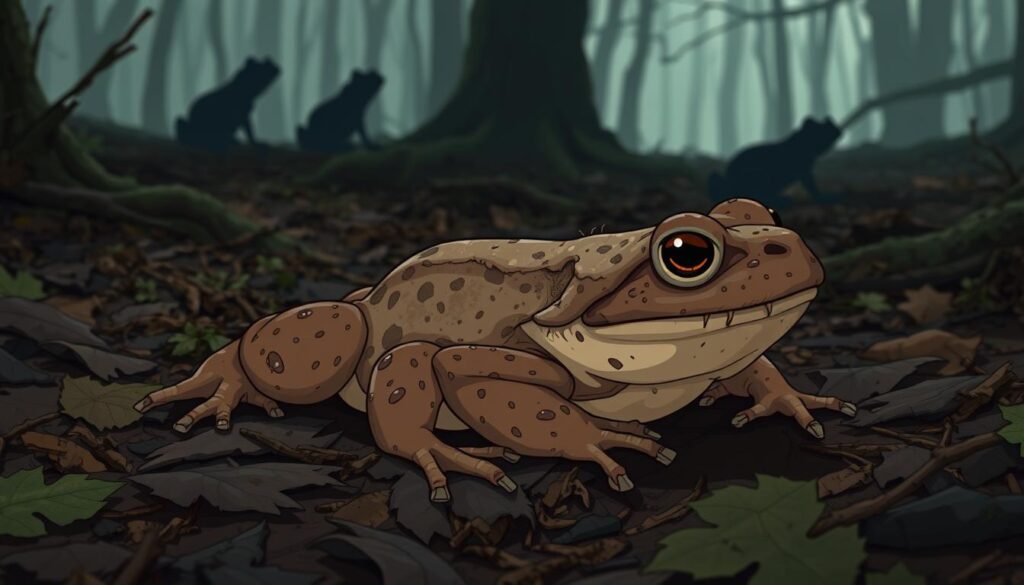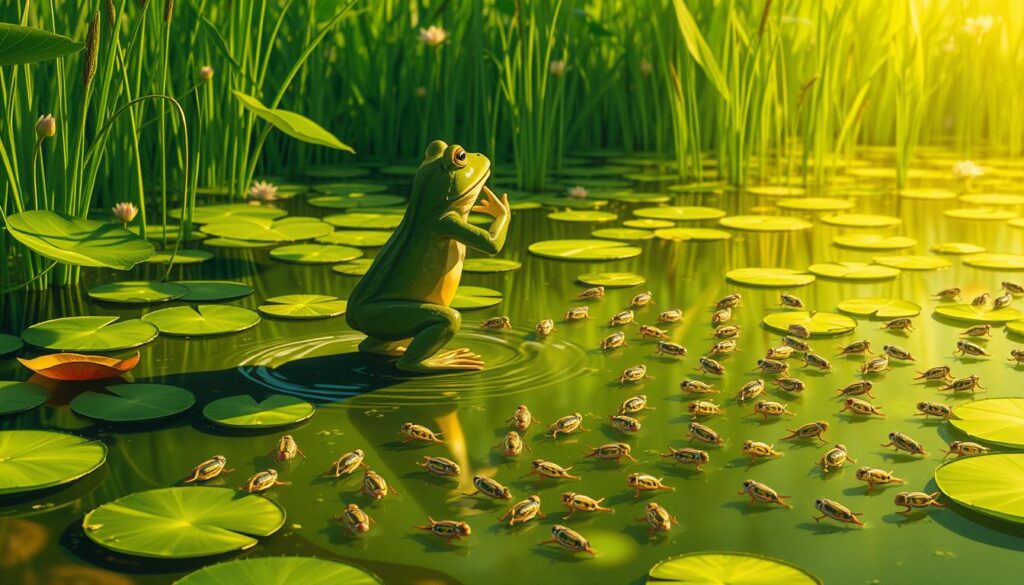Did you know that 40.7% of amphibian species worldwide are now threatened with extinction? This alarming statistic, from the latest IUCN data, highlights the urgent crisis facing these vital creatures. Amphibians, often called nature’s indicators, are particularly sensitive to environmental changes due to their permeable skin and unique life cycles.
Recent research shows that climate shifts are emerging as a primary threat, contributing to 39% of status deteriorations since 2004. The 2022 Global Amphibian Assessment, analyzing over 8,000 species, reveals a grim picture. Habitat loss, diseases like chytrid fungus, and the compounding effects of a warming planet are pushing many species to the brink.
Regional hotspots, such as the Tropical Andes and Mesoamerica, are especially vulnerable. This article synthesizes the latest findings on the physiological, behavioral, and demographic impacts of these changes. It also explores conservation efforts to protect these essential species.
Key Takeaways
- 40.7% of amphibian species are threatened globally, the highest among vertebrates.
- Climate shifts are a growing threat, linked to 39% of status deteriorations since 2004.
- Amphibians are environmental indicators due to their sensitive skin and life cycles.
- The 2022 Global Amphibian Assessment analyzed over 8,000 species.
- Key threats include habitat loss, disease, and climate synergies.
- Regional hotspots like the Tropical Andes are at high risk.
- Conservation efforts are critical to protecting these species.
Introduction to Amphibians and Climate Change
Amphibians are uniquely vulnerable to environmental shifts due to their biological traits. Their permeable skin, unshelled eggs, and ectothermic nature make them highly sensitive to changes in temperature and moisture levels. These factors place them at greater risk compared to other species.
Why Amphibians Are Sensitive to Climate Change
One of the primary reasons for their vulnerability is their permeable skin. This feature allows them to absorb water and oxygen directly, but it also increases the risk of dehydration in drier conditions. Additionally, their unshelled eggs are prone to desiccation, especially in habitats that are drying out due to environmental changes.
Amphibians are ectothermic, meaning they rely on external heat sources to regulate their body temperature. This makes them highly dependent on stable environmental conditions. When temperatures fluctuate, their ability to survive and reproduce is significantly impacted.
Overview of Recent Research Findings
Recent studies highlight the compounding effects of environmental shifts on amphibians. For example, the 2022 Global Amphibian Assessment analyzed over 8,000 species and found that 29% are impacted by both environmental changes and diseases. This dual threat is pushing many species closer to extinction.
Technological advances, such as biophysical models, are helping researchers better understand microclimates and their effects on these species. However, data gaps remain. Only 7.5% of amphibian species have been studied for thermal tolerance, leaving many questions unanswered.
Key studies, like the 2023 TerraClimate projections, emphasize the urgent need for conservation efforts. Protecting amphibians requires addressing both environmental changes and habitat degradation to ensure their survival.
The Global Amphibian Crisis
Recent data reveals a stark reality: amphibians are disappearing at an alarming rate. According to the IUCN Red List, 37 species have gone extinct since 1980, with numbers rising steadily. This crisis is driven by a combination of factors, including habitat loss, disease, and environmental shifts.

Historically, disease was the primary cause of declines, accounting for 58% of cases before 2004. However, the landscape has shifted. Today, environmental changes are the leading threat, impacting over 40% of species. Habitat loss due to agriculture expansion affects a staggering 77% of amphibian populations.
Current Status of Amphibian Populations
Amphibians are facing population declines across the globe. Regions like the Caribbean islands, Madagascar, and the Western Ghats are particularly vulnerable. These areas are hotspots for biodiversity but are also under immense pressure from human activities and environmental changes.
The 2024 TerraClimate projections paint a grim picture. At a global temperature increase of +4°C, 7.5% of species will exceed their thermal limits. This phenomenon, known as “thermal squeeze,” highlights the urgent need for conservation efforts.
Key Threats Identified in Recent Studies
Recent studies emphasize the compounding effects of multiple threats. For example, the Neotropics face higher vulnerability compared to Australasia due to habitat degradation and environmental shifts. Conservation efforts have helped 63 species recover over the last 40 years, but much more needs to be done.
To learn more about ongoing conservation initiatives, visit the Natural History Museum’s report on amphibian declines. Protecting these species requires addressing both immediate threats and long-term environmental challenges.
Physiological Impacts of Climate Change on Amphibians
The physiological effects of environmental shifts on amphibians are becoming increasingly evident. These changes are reshaping their bodies, health, and survival strategies. From shrinking body sizes to weakened immune systems, amphibians are facing unprecedented challenges.

Body Size and Condition
One striking trend is the reduction in body size. A 22-year study on UK Bufo bufo (common toads) found a 20% decrease in body size. This phenomenon is linked to metabolic stress caused by fluctuating environmental conditions.
In Appalachian salamanders, researchers observed similar patterns. Caruso et al. (2015) documented how these species struggle to maintain energy balance in warmer habitats. Smaller body sizes may reduce their ability to store energy, impacting survival and reproduction.
Immune Functioning and Disease Susceptibility
Environmental shifts also weaken immune systems. California newts experienced a 20% drop in body condition, as noted by Bucciarelli (2020). This decline makes them more vulnerable to diseases like chytrid fungus.
Temperature extremes further exacerbate this issue. For example, the Greenland block effect has been linked to increased disease susceptibility in amphibians. Warmer temperatures can suppress immune responses, creating a perfect storm for pathogen outbreaks.
Hydroperiod changes are another concern. Shorter wet seasons force larvae to undergo early metamorphosis, often resulting in smaller, less resilient adults. This process, known as “eco-immunology,” highlights the complex interplay between environmental conditions and immune health.
Interestingly, warming climates can also cause paradoxical cold stress. Amphibians adapted to specific temperature ranges may struggle to cope with sudden drops, even in a generally warmer world.
| Impact | Example | Consequence |
|---|---|---|
| Body Size Reduction | UK Bufo bufo (20% smaller) | Lower energy storage, reduced survival |
| Immune Suppression | California newts (20% body condition drop) | Increased disease susceptibility |
| Hydroperiod Changes | Early metamorphosis in larvae | Smaller, less resilient adults |
| Temperature Extremes | Greenland block effect | Higher pathogen outbreaks |
Behavioral Changes in Amphibians Due to Climate Change
Behavioral shifts in amphibians are a direct response to environmental pressures. These creatures are altering their habits to survive in a rapidly changing world. From thermoregulation to breeding patterns, their adaptations are both fascinating and concerning.

Thermoregulatory Behaviors
Amphibians are ectothermic, relying on external heat sources to regulate their body temperature. In warmer climates, many species are adopting arboreal strategies to stay cool. For example, tree-dwelling frogs seek shade in dense vegetation to avoid overheating.
Desert species face a unique challenge known as the “hydroperiod gamble.” They must time their breeding with unpredictable rainfall events. If they miss this window, their survival is at risk. This highlights the delicate balance amphibians must maintain in harsh environments.
Shifts in Breeding Patterns
Breeding patterns are changing rapidly. Spring Peepers, for instance, are now breeding 2.3 days earlier each decade. This shift is driven by warmer temperatures and altered seasonal cues.
In tropical regions, rainfall triggers breeding, while temperate species rely on temperature cues. These differences can lead to mismatches in predator-prey relationships. For example, if frogs breed earlier, their tadpoles may hatch before their food sources are available.
Failed brumation emergence is another concern. In colder regions, some frogs are unable to emerge from their winter hibernation due to sudden freezes. This has led to increased mortality in certain populations.
As phenology shifts occur twice as fast in amphibians compared to birds and butterflies, the need for conservation becomes even more urgent. Understanding these behavioral changes is key to protecting these vital species.
Demographic Impacts of Climate Change
Amphibians are experiencing significant shifts in their living conditions. These changes are altering their distribution, population sizes, and survival rates. From elevation shifts to habitat degradation, the challenges are mounting.

Range Shifts and Habitat Loss
Many species are moving to higher elevations to escape warming temperatures. In the Andes, amphibians have shifted an average of 152 meters upslope. This movement is driven by the need to find suitable thermal conditions.
However, vertical range constraints pose a serious threat. Venezuelan tepui endemics, for example, face extinction risks because they cannot move higher. Their limited habitat makes them particularly vulnerable.
Wetland loss is another critical issue. In the US, 37% of vernal pools have disappeared since the 1980s. These seasonal wetlands are essential for breeding, and their loss has devastating effects on amphibian populations.
Population Declines and Extirpation
Population declines are widespread, with some species facing local extirpation. In Australia, wildfires have led to significant declines in Batrachoseps salamanders. These events highlight the fragility of isolated populations.
Genetic bottlenecking is a growing concern. Smaller, fragmented populations have reduced genetic diversity, making them less resilient to environmental changes. This phenomenon is particularly evident in regions with high levels of habitat fragmentation.
Source-sink dynamics are also shifting. In some areas, populations that once thrived are now struggling to survive. Conservationists are exploring assisted colonization as a potential solution. This strategy involves relocating species to more suitable habitats to ensure their survival.
| Impact | Example | Consequence |
|---|---|---|
| Elevation Shifts | Andes amphibians (152m upslope) | Vertical range constraints |
| Wetland Loss | US vernal pools (37% loss) | Reduced breeding success |
| Population Decline | Australian Batrachoseps salamanders | Local extirpation risks |
| Genetic Bottlenecking | Isolated populations | Reduced resilience |
Climate Change and Amphibian Extinction Risks
The threat of extinction looms large for many amphibian species. According to the IUCN, 222 potential extinctions could be confirmed if critically endangered populations are lost. This alarming trend highlights the urgent need for conservation efforts.

Species Most at Risk
Harlequin toads (Atelopus) are among the most endangered groups, with 83% of their species at risk. These toads are particularly vulnerable due to their reliance on specific microhabitats in cloud forests. When one species disappears, it can trigger a domino effect, destabilizing entire ecosystems.
Other high-risk groups include slow-reproducing species facing cryptic extinction debt. These populations may appear stable but are silently declining due to environmental pressures. Conservationists are working to address these challenges through initiatives like captive breeding programs for the Corroboree frog.
Projected Extinction Rates
Recent projections paint a grim picture. At a global temperature increase of +4°C, 391 species could exceed their thermal tolerance thresholds. The average critical thermal maximum (CTmax) for amphibians is 35.9°C, but many are already experiencing 22.8% annual overheating days.
“The loss of amphibians would have cascading effects on ecosystems, from pest control to nutrient cycling.”
Comparing Red List Index (RLI) trends, amphibians score 0.89, lower than birds at 0.94. This disparity underscores the heightened vulnerability of amphibians to environmental change. Wetland loss and habitat fragmentation further exacerbate these risks.
| Risk Factor | Example | Impact |
|---|---|---|
| Thermal Overheating | 391 species at +4°C | Exceeding CTmax thresholds |
| Habitat Loss | Cloud forest degradation | Domino effects on ecosystems |
| Cryptic Extinction Debt | Slow-reproducing species | Silent population declines |
In the U.S., 20% of amphibian species are at risk, partly due to their permeable skin, which makes them sensitive to environmental change and pollutants. For more insights on amphibian care and conservation, visit this guide.
The Role of Disease in Amphibian Declines
Disease has become a critical factor in the decline of amphibian populations worldwide. Pathogens like chytrid fungus and emerging infections are reshaping the survival prospects of these species. The interplay between disease and environmental shifts is creating a perfect storm for amphibian populations.

Chytridiomycosis and Its Impact
Chytridiomycosis, caused by the fungus Batrachochytrium dendrobatidis (Bd), has driven over 90 species to extinction since the 1970s. This pathogen thrives in temperatures between 17-25°C, making montane regions particularly vulnerable. As temperatures rise, Bd benefits from expanded thermal zones, increasing its spread.
In Europe, the related fungus Batrachochytrium salamandrivorans (Bsal) is causing new outbreaks. Fire salamanders in the Netherlands have been severely affected, highlighting the rapid spread of this pathogen. These interactions between disease and environmental changes are accelerating amphibian declines.
Emerging Pathogens and Climate Change
Novel myxosporean parasites are emerging in warming waters, adding to the challenges faced by amphibians. These pathogens exploit weakened immune systems, which are further compromised by environmental stressors. For example, Alpine tree frogs have developed resistance genes, offering hope for some species.
Vaccine development is progressing, with promising results in combating chytrid infections. However, the broader issue of climate change exacerbating disease spread remains unresolved. Conservation efforts must address both immediate threats and long-term environmental challenges to protect these vital species.
“The loss of amphibians to disease is not just a biodiversity crisis—it’s a warning sign for the health of our ecosystems.”
Understanding the interactions between disease and environmental shifts is key to developing effective conservation strategies. By addressing these dual threats, we can work toward a future where amphibians thrive.
Habitat Loss and Degradation
Habitat loss is reshaping the survival landscape for amphibians worldwide. From tropical rainforests to temperate wetlands, the destruction of natural environments is one of the most significant threats these species face. Agricultural expansion, deforestation, and urbanization are driving forces behind this crisis.

Agricultural Expansion and Deforestation
Agriculture impacts 77% of amphibian species globally. In the Amazon, 17% of the rainforest has been lost, severely affecting Dendrobatid frogs. These species rely on the dense canopy for survival, and its removal disrupts their ecosystems.
In Southeast Asia, palm oil plantations are replacing critical habitats. Meanwhile, cattle ranching in Central America is fragmenting amphibian populations. These activities not only destroy habitats but also introduce pollutants that harm amphibians.
Urbanization and Infrastructure Development
Urban growth is another major driver of habitat loss. In Europe, over 1 million amphibians are killed annually on roads. This road mortality is particularly devastating for species like the Korean salamander, which faces steep population declines.
Light pollution from urban areas disrupts nocturnal species. Many amphibians rely on darkness for feeding and breeding, and artificial lights can disorient them. Additionally, microplastics are infiltrating aquatic systems, posing a new threat to amphibians in polluted regions.
- Deforestation in the Amazon affects Dendrobatid frogs.
- Palm oil plantations replace critical habitats in Southeast Asia.
- Over 1 million amphibians are killed annually on EU roads.
- Light pollution disrupts nocturnal species’ behaviors.
- Microplastics infiltrate aquatic systems, harming amphibians.
Despite these challenges, some conservation efforts are making a difference. Costa Rica’s riparian corridors are a success story, providing safe habitats for amphibians. These initiatives show that protecting and restoring habitats can help mitigate the impacts of habitat loss.
“The loss of natural habitats is not just an environmental issue—it’s a survival crisis for amphibians.”
Addressing habitat loss requires a combination of conservation strategies and sustainable practices. By protecting these vital environments, we can ensure a future where amphibians thrive.
Microhabitats and Thermal Refugia
Microhabitats play a crucial role in helping amphibians adapt to environmental challenges. These small-scale environments, such as dense vegetation and water bodies, provide essential support for survival. They act as thermal refugia, offering protection from extreme temperatures and other stressors.

Importance of Vegetation and Water Bodies
Vegetation and water are vital for creating safe spaces. Studies show that dense vegetation reduces overheating risk by 32.5%. Water bodies, on the other hand, prevent 100% overheating until temperatures reach +4°C. These environments are lifelines for many species.
For example, arboreal species like Tepui marsupial frogs benefit from cooler microclimates in tree canopies. Terrestrial species, however, rely on shaded areas to avoid overheating. Biophysical models reveal that arboreal habitats offer a thermal safety margin (TSM) of 12.23°C, compared to 11.69°C for terrestrial habitats.
How Microhabitats Buffer Climate Effects
Microhabitats provide critical buffering against environmental extremes. Shade from vegetation prevents 207 overheating days annually when coverage reaches 85%. Tropical species require at least 70% canopy cover to thrive.
Ephemeral water strategies, like rapid metamorphosis in spadefoot toads, also play a role. These adaptations allow species to complete their life cycles before water sources dry up. Urban areas can even serve as refuges, with stormwater retention ponds supporting amphibian populations.
However, not all microhabitats are reliable. Drying bromeliads, for instance, can become false refugia, trapping species in unsuitable conditions. Conservation efforts must focus on preserving and enhancing these critical environments to ensure amphibian survival.
Climate Change and Amphibian Reproduction
Environmental shifts are reshaping amphibian reproduction in profound ways. From altered breeding patterns to disrupted larval development, these changes threaten the survival of many species. Understanding these impacts is crucial for effective conservation efforts.

Effects on Breeding Success
Breeding success is declining due to environmental stressors. For example, Andean glass frogs face high egg mortality due to desiccation risks. Temperature-dependent sex determination is also shifting ratios, creating imbalances in populations.
Pesticide-climate synergies further exacerbate these challenges. Atrazine, combined with heat stress, reduces reproductive output in many species. European common frogs are adapting through plastic responses, but these may not be enough to ensure long-term survival.
Changes in Larval Development
Larval development is particularly vulnerable to environmental changes. At +4°C, 76% of larvae experience mortality, as seen in experimental studies. Wood frogs show immune suppression after forced metamorphosis, reducing their chances of survival.
Hydroperiod thresholds are critical for successful metamorphosis. A minimum of 60 days is required for many species. Assisted reproduction technologies, like cryopreservation, offer hope but are not yet widely implemented.
“The challenges facing amphibian reproduction are a stark reminder of the fragility of these species in a changing world.”
r-strategists, which produce many offspring, are more vulnerable than K-strategists, which invest heavily in fewer offspring. This contrast highlights the diverse ways environmental changes impact amphibian reproduction. Addressing these issues requires a multifaceted approach, combining conservation strategies with innovative technologies.
Amphibian Resilience to Climate Change
Amphibians are showing remarkable resilience in the face of environmental challenges. Despite their sensitivity, many species are adapting through plasticity and evolutionary changes. These responses are critical for their survival in a rapidly changing world.
Adaptive Responses and Plasticity
One example of plasticity is the Australian Litoria species, which has recovered significantly after chytrid fungus outbreaks. This recovery highlights their ability to adapt to disease pressures. Epigenetic changes, like methylation patterns in heat-stressed Xenopus, also play a role in their survival.
Plasticity allows amphibians to adjust their behavior and physiology without altering their genetic makeup. For instance, some species shift their breeding times or seek cooler microhabitats to avoid extreme temperatures. These short-term responses are vital for coping with immediate threats.
Evolutionary Rescue and Genetic Adaptation
In some cases, rapid evolution is helping species survive. The Cuban treefrog, for example, has adapted to urban heat islands through genetic changes. This kind of adaptation is essential for long-term survival in changing environments.
However, not all species can evolve quickly enough. Research shows that a minimum of 5% heritability is needed for evolutionary rescue to occur. Specialist species, with narrow ecological niches, face greater risks than generalists, which can thrive in diverse conditions.
“The ability of amphibians to adapt through plasticity and evolution is a testament to their resilience, but their limits must not be overlooked.”
| Strategy | Example | Outcome |
|---|---|---|
| Plasticity | Australian Litoria recovery | Post-chytrid population rebound |
| Epigenetics | Heat-stressed Xenopus | Methylation patterns enhance survival |
| Rapid Evolution | Cuban treefrog urban adaptation | Genetic changes for heat tolerance |
| Specialist vs Generalist | CR amphibians’ narrow safety margins | Specialists face higher extinction risks |
Ex situ conservation genetics, like captive breeding programs, are helping preserve genetic diversity. However, the narrow safety margins of some species, like those in Costa Rica, highlight the limits of adaptation. Protecting these species requires a combination of conservation strategies and innovative approaches.
Conservation Efforts for Amphibians
Conservation efforts are making a difference for amphibians worldwide. From habitat protection to global initiatives, these strategies are helping species recover and thrive. Recent successes highlight the importance of dedicated action and innovative approaches.
Effective Habitat Protection Strategies
Habitat protection is a cornerstone of amphibian conservation. Studies show that 63 species have improved due to focused efforts. For example, maintaining 85% shade in critical areas reduces overheating risks by 32.5%, providing safer environments for these sensitive creatures.
Microhabitat engineering, such as artificial hibernacula, has also proven effective. These structures offer safe spaces for species during harsh conditions. Additionally, citizen science projects like FrogID have contributed valuable data, helping researchers identify and protect vulnerable populations.
Global Initiatives and Success Stories
Global initiatives are showcasing remarkable success stories. The Amphibian Rescue and Conservation (ARK) program has successfully bred 47 species in captivity. One standout example is the Kihansi spray toad, which was reintroduced to its native habitat after being declared extinct in the wild.
Policy wins, like the EPA’s wetland protections, have also made a significant impact. The Mesoamerican Biological Corridor connects fragmented habitats, allowing species to migrate and adapt to changing conditions. Novel funding methods, such as amphibian crypto-tokens, are emerging to support these efforts.
| Initiative | Impact |
|---|---|
| ARK Program | 47 species bred in captivity |
| Kihansi Spray Toad Reintroduction | Successful return to native habitat |
| EPA Wetland Protections | Enhanced habitat preservation |
| Mesoamerican Biological Corridor | Connected fragmented habitats |
“The success of these initiatives demonstrates the power of collaboration and innovation in conservation.”
These efforts show that with the right strategies, amphibians can recover and thrive. Protecting these species is not just about preserving biodiversity—it’s about ensuring the health of our ecosystems for future generations.
Future Projections for Amphibians Under Climate Change
The future of amphibians hangs in the balance as environmental shifts accelerate. Scientists are using advanced models to predict how different warming scenarios will impact these sensitive creatures. The results are both revealing and alarming.
Under the IPCC’s RCP 2.6 scenario, which assumes significant emission reductions, the risk of extinction for amphibians is relatively lower. However, in the RCP 8.5 scenario, which represents a high-emission future, the risk triples. This stark contrast highlights the urgency of addressing global emissions.
Predictions for Different Warming Scenarios
At +4°C, 7.5% of amphibian species could exceed their thermal limits, pushing them toward extinction. Thermal niche erosion is projected to affect 89% of species by 2100. These projections underscore the fragility of amphibians in a warming world.
Ocean-atmosphere oscillations, such as ENSO, further complicate the picture. These natural cycles can amplify temperature extremes, creating additional stress for amphibians. For example, El Niño events have been linked to increased mortality in tropical species.
- RCP 2.6: Lower extinction risk with emission reductions.
- RCP 8.5: Tripled extinction risk in high-emission scenarios.
- Thermal niche erosion: 89% of species affected by 2100.
Regions Most Vulnerable to Future Changes
Certain regions are at higher risk due to their unique environmental conditions. Northern Australia and the southeastern United States are identified as hotspots for amphibian vulnerability. These areas face a combination of rising temperatures, habitat loss, and increased disease prevalence.
Climate analogs, such as the Appalachian to Canadian range shifts, offer insights into how species might adapt. However, not all amphibians can relocate or adjust quickly enough. Urban heat islands, surprisingly, are emerging as unexpected refuges for some species, providing microhabitats that buffer against extreme conditions.
“The cascading effects of amphibian extinctions could destabilize entire ecosystems, from pest control to nutrient cycling.”
Predator-prey mismatches are another concern. As amphibians shift their breeding times or habitats, their predators may not adapt at the same pace. This imbalance could lead to cascading extinctions, further threatening biodiversity.
How Climate Change Affects Amphibians: A Synthesis
The intersection of habitat loss, disease, and environmental shifts presents a critical challenge for amphibians. These three factors, often referred to as the “triple threat,” are driving many species toward extinction. Recent research highlights the urgent need for a comprehensive approach to conservation.
Understanding the interplay between these threats is essential for developing effective strategies. For example, habitat loss disrupts ecosystems, making species more vulnerable to diseases like chytrid fungus. At the same time, environmental shifts exacerbate these risks by altering temperature and moisture levels.
Key Findings from Recent Research
Recent studies have uncovered several critical findings. First, habitat loss impacts 77% of amphibian species globally. Second, diseases like chytrid fungus have driven over 90 species to extinction. Finally, environmental shifts are now the primary threat, affecting 40% of species.
These findings underscore the need for immediate action. The IUCN Green Status framework offers a roadmap for recovery, focusing on species’ ecological roles and recovery potential. However, funding gaps remain a significant barrier, with an estimated $50 million per year needed for priority species.
Implications for Conservation and Policy
The implications of these threats are far-reaching. Conservation efforts must adopt a three-pillar approach: Protect, Connect, and Adapt. Protecting habitats, connecting fragmented ecosystems, and helping species adapt to new conditions are essential steps.
One Health connections also play a vital role. Amphibians serve as biomonitors, providing early warnings of environmental changes. Protecting them benefits entire ecosystems and human health. A Global Amphibian Agreement (GGA) could unify international efforts, ensuring coordinated action.
“The survival of amphibians is not just a conservation issue—it’s a call to protect the health of our planet.”
Ending on a hopeful note, initiatives like the conservation of the Purple frog in India show that dedicated efforts can make a difference. By addressing the triple threat and implementing innovative strategies, we can secure a future for these vital species.
Conclusion
With 40.7% of amphibian species threatened, the time to act is now. The next decade is critical for their survival, but there is still hope. Conservation efforts, like the recovery of the Kihansi spray toad, show what’s possible when we take action.
Individuals can make a difference by participating in citizen science projects or creating habitat gardens. Technology, such as AI population monitoring, offers new tools to protect these species. Scientists are also calling for a global monitoring network to track their progress.
Amphibians are resilient, but they need our help. By working together, we can ensure a brighter future for these vital creatures and the ecosystems they support.
FAQ
Why are amphibians particularly vulnerable to environmental shifts?
What are the main threats to amphibian populations today?
How does rising temperature affect amphibian reproduction?
Which species are most at risk from these environmental changes?
What role do diseases play in amphibian declines?
How can conservation efforts help protect amphibians?
Are there any regions more vulnerable to these changes?
Can amphibians adapt to these changing conditions?
What are the long-term projections for amphibian populations?

I’m Lena Adams—a product of an unconventional upbringing in the African wilderness. My father, a daring explorer of African wildlife, sparked my fascination with reptiles, a passion that intertwined with the tragic loss of my mother during an expedition, leaving an indelible mark on my life. Driven to understand the creatures that captivated my parents, I embarked on my journey, sharing insights about reptiles, frogs, and lizards on my website. Through my explorations and conservation efforts, I honour my family’s legacy while seeking connections—to the creatures, nature, and the mother whose presence I yearn to understand.
